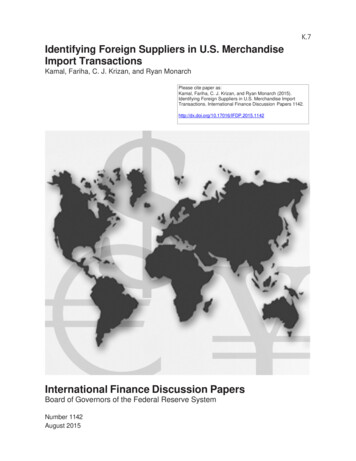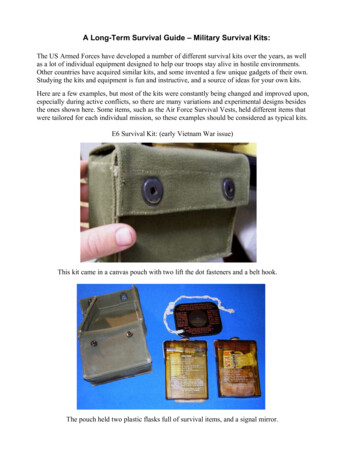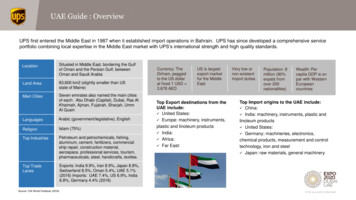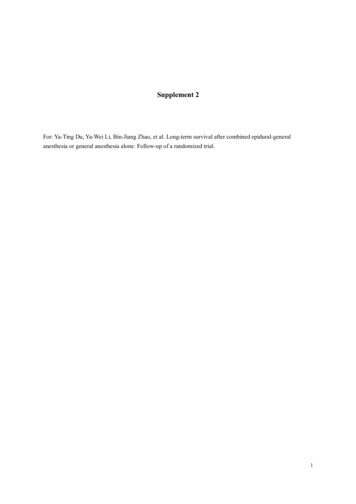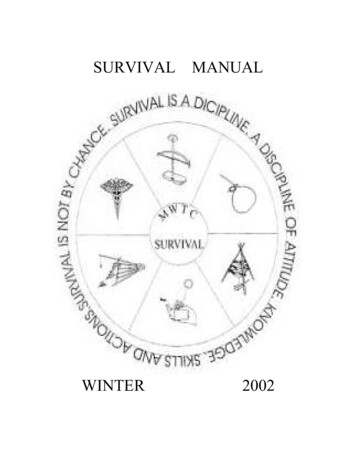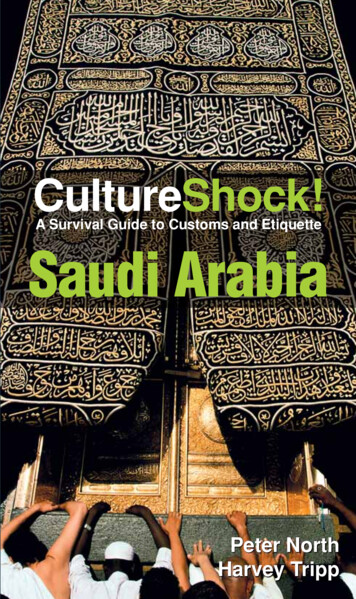
Transcription
CultureShock!A Survival Guide to Customs and EtiquetteSaudi ArabiaPeter NorthHarvey Tripp
CultureShock!A Survival Guide to Customs and EtiquetteSaudiArabiaPeter NorthHarvey Tripp
This 3rd edition published in 2009 by:Marshall Cavendish Corporation99 White Plains RoadTarrytown NY 10591-9001www.marshallcavendish.usFirst published in 2003 by Times Media Pte Ltd; 2nd edition published in 2006,reprinted 2007. 2009 Marshall Cavendish International (Asia) Private LimitedAll rights reservedNo part of this publication may be reproduced, stored in a retrieval systemor transmitted, in any form or by any means, electronic, mechanical,photocopying, recording or otherwise, without the prior permission ofthe copyright owner. Request for permission should be addressed to thePublisher, Marshall Cavendish International (Asia) Private Limited, 1 NewIndustrial Road, Singapore 536196. Tel: (65) 6213 9300, fax: (65) 6285 4871.E-mail: genref@sg.marshallcavendish.comThe publisher makes no representation or warranties with respect to thecontents of this book, and specifically disclaims any implied warranties ormerchantability or fitness for any particular purpose, and shall in no eventsbe liable for any loss of profit or any other commercial damage, including butnot limited to special, incidental, consequential, or other damages.Other Marshall Cavendish Offices:Marshall Cavendish International (Asia) Pte Ltd. 1 New Industrial Road,Singapore 536196 Q Marshall Cavendish Ltd. 5th Floor, 32-38 Saffron Hill,London EC1N 8FH, UK Q Marshall Cavendish International (Thailand) Co Ltd.253 Asoke, 12th Flr, Sukhumvit 21 Road, Klongtoey Nua, Wattana, Bangkok10110, Thailand Q Marshall Cavendish (Malaysia) Sdn Bhd, Times Subang,Lot 46, Subang Hi-Tech Industrial Park, Batu Tiga, 40000 Shah Alam, SelangorDarul Ehsan, MalaysiaMarshall Cavendish is a trademark of Times Publishing LimitedISBN: 978-07614-5674-2Please contact the publisher for the Library of Congress catalogue numberPrinted in Singapore by Times Printers Pte LtdPhoto Credits:All black and white photos from altTYPE/Reuters except pages 59, 117 (IanBlain); page 7 (Focus Team, Italy); page 181 (Angela Jackson); pages 13, 152(Photolibrary). Colour photos from Corbis pages a, b–c, f–g, i, j–k; altTYPE/Reuters d–e, p; Photolibrary pages h, l–m, n–o Q Cover photo: CorbisAll illustrations by TRIGG
ABOUT THE SERIESCulture shock is a state of disorientation that can come overanyone who has been thrust into unknown surroundings, awayfrom one’s comfort zone. CultureShock! is a series of trustedand reputed guides which has, for decades, been helpingexpatriates and long-term visitors to cushion the impact ofculture shock whenever they move to a new country.Written by people who have lived in the country andexperienced culture shock themselves, the authors share all theinformation necessary for anyone to cope with these feelingsof disorientation more effectively. The guides are written in astyle that is easy to read and covers a range of topics that willarm readers with enough advice, hints and tips to make theirlives as normal as possible again.Each book is structured in the same manner. It beginswith the first impressions that visitors will have of that city orcountry. To understand a culture, one must first understand thepeople—where they came from, who they are, the values andtraditions they live by, as well as their customs and etiquette.This is covered in the first half of the book.Then on with the practical aspects—how to settle in withthe greatest of ease. Authors walk readers through topicssuch as how to find accommodation, get the utilities andtelecommunications up and running, enrol the children inschool and keep in the best of health. But that’s not all. Oncethe essentials are out of the way, venture out and try the food,enjoy more of the culture and travel to other areas. Then beimmersed in the language of the country before discoveringmore about the business side of things.To round off, snippets of basic information are offeredbefore readers are ‘tested’ on customs and etiquette of thecountry. Useful words and phrases, a comprehensive resourceguide and list of books for further research are also includedfor easy reference.
CONTENTSForeword viChapter 4Acknowledgements viiiGetting toKnow the SaudisMap of Saudi Arabia xChapter 1First ImpressionsGetting There13Chapter 2Land and Historyof Saudi ArabiaThe Beginnings101177The Cultural Divide78The Worker Bees79The Pecking Order82Long Term Immigrants83Separate Societies84Expatriate Women86Male Bonding89Dress Code forSaudi Men90Dress Code forSaudi Women92Dress Code forAliens: Men9496The Lie of the Land.12Trading with the World14The Al Sauds16Saudi Arabia: the Early Days18The Origin of Islam22Dress Code forAliens: Women28Religious FreedomsToday’s Islam30Weddings and Funerals100Pan-Arab Brotherhood:In Formation or Disarray?Falling Foul of the Law10135Security and Safety102Sunnis and Shi’ites38The Ultimate Penalty104Saudi Arabia and Israel39Paying Blood Money106Oil and the Economy41The Governmentof the Present DaySecurity of Saudi Arabia:the Country10645The Spread of Islam98Chapter 5Settling InChapter 3Who arethe Saudis?49111Expectations112Visas and Documentation113From Bedouinism to Opulence50Pre-Arrival Checks115The Population Explosion50Accommodation116Family Values52Names and Labels54Facilities forthe Handicapped119Money and Banking120Interaction Betweenthe Sexes55Appliances122Saudi Women59Women and Religion62Help Aroundthe Home123Acquiring an Identity62Travel by Car123Women in the Workforce65Taxis128Qur’an and the Law67Postal129Swapping Cultures70Television130Saudi Arabia’s Bedouins71Shopping132Education73
Learning Arabic197Common Arabic expressions198136Saudi’s Second Language199Traditional Fare137Body Language199Restaurants139Domestic Hospitality140Entertaining,Bedouin Style142Coffee Shops144Alcohol146Chapter 6Food andEntertainingChapter 9Working andDoing Businessin Saudi Arabia201Economic Developmentand the Labour Force202Why Can’t the SaudisRun Their Own Country?203149Will You Be ReplacedBy a Saudi?207Survivng the Climate150Perpetual Trainees211What Day Is It?153Public Holidays156Inshallah: Philosophyor Crutch?213Religion in the Workplace213Employment Contracts216Commercial Law220Income Tax221Negative Comment222Chapter 7Sights and Soundsof Saudi ArabiaArchitectureMuseumsLiterary and Visual ArtsFinding Your Way Around157158159161The Saudi ArabianCountryside162Getting On With the Boss222Hotels167Who’s In Business224Travel by Train168Corruption226Travel by Air168The NumberOne AttractionFurther Informationon Business Contacts227169The Bureaucracy229Touring Outsidethe Kingdom176Taking Pictures178Entertainment and Leisure179Saudis and Sport180Guest Workers and Sports188Speaking ArabicReading ArabicWriting ArabicArabic as Spokenby ArabsSaudi Arabiaat a Glance232Famous Peopleof Saudi Arabia237Culture Quiz242191Do’s and Don’ts248192Glossary250195Resource Guide253195Further Reading260About the Authors266Index268Chapter 8Learning ArabicChapter 10196
viFOREWORDIn his book The 100: A Ranking of the Most Influential Personsin History, author Michael H Hart judged that the world’s mostinfluential person of all time was an Arab trader who lived atthe turn of the 6th and 7th centuries in Mecca in present daySaudi Arabia. The name of this individual was Muhammad, thefounder of the Muslim religion. To Muslims, presently 20 percent of the global population, Muhammad was the Prophet whodelivered God’s word to the world. To non-Muslims, Muhammadwas the man who delivered the Muslim religion to the world.Either way, Muhammad’s effect on global human affairs sincehis own time has been profound.The other major influence, in terms of recent global interestin Saudi Arabia, was the discovery on the Arabian Peninsulaof the world’s biggest oil deposits. The development of theSaudi oil fields after the 1940s cast Saudi Arabia as the swingsupplier of the world’s energy and the most influential memberof OPEC (Organisation of Petroleum Exporting Countries).The interaction of these two factors, Islam and oil, have madeSaudi Arabia one of the most pivotal countries on the planet.Oil and the income it has generated has had a profoundeffect on the Saudi culture in this once dirt-poor country oflimited interest to the rest of the world. In the modern era,Saudi Arabia’s economic prospects have varied with the oilprice. In 1940s and 1950s, as the the first oil revenue flowedinto the country, the Saudi Royal family first experimented withconspicuous consumption in its most extreme form—nearlydriving the country bankrupt in the process. After the firstbig oil price increase in 1973, Saudi Arabia spent some ofits petrodollars on national development and invested somein Western banks. The Western banks in turn invested inLatin American countries, which subsequently announcedan inability to repay their debts. Laundered through variouscountries, these petrodollars found themselves in the accountsof Swiss banks in the name of various unsavoury ThirdWorld dictators—well beyond the reach of the Treasury ofSaudi Arabia, the ostensible owner of the money. The priceof oil peaked again in 1979 during the Iranian Revolution,but then slumped over the 1980s and 1990s when SaudiArabia survived by deficit financing, building up a massive
viioverseas debt. Since the oil price spike that started in around2002, Saudi Arabia has applied the bulk of its funds fromthe booming oil price into paying off its accumulated debtand increasing its rate of development. As is commonknowledge, the oil price peaked at US 147 in mid 2008,then quickly slumped as the great global economicmeltdown of 2008/2009 gathered pace. At time of writingthe oil price is around US 50. Where it will go from thereis anyone’s guess.To implement its social and physical developmentprogramme, Saudi Arabia has, for many years, imported fromother countries a guest workforce of skilled and unskilledlabour. Saudi Arabia has a guest labour force five to six millionstrong in a total population of 28 million. Opportunities aremany for guest workers inside Saudi Arabia to undertakean enormous variety of labour contracts, occupationsand industries.This book is principally written as an information guideto Saudi’s army of guest workers. It also offers advice andinformation for those visiting the kingdom to do business, visitfamily members of guest workers and many other reasons.While the major viewpoint taken is that of the Westernvisitor who has accepted employment in Saudi Arabia, or isconsidering doing so, the book also contains helpful hints forguest workers from other countries. It offers thumbnail sketchesof important historical accounts that have created presentday cultural attitudes, and includes information of day-to-dayevents within Saudi Arabia.As the title of the book suggests, an assignment in Saudi Arabiais an experience in the clash of cultures. Saudi Arabia is locatedin a part of the world where the cultural mix is pronounced.Three of the world’s dominant religions—Islam, Christianityand Judaism—originated in these ancient lands. In this region,Islam, Christianity, Judaism, Buddhism, Taoism and various other‘isms’ uneasily rub shoulders against each other on a daily basis.Culture shock is a part of life in Saudi Arabia, both for the guestworkers and the indigenous population. Avoiding the pitfallsof culture shock and getting the best out of your time in SaudiArabia are two of the main themes of this book.
viiiACKNOWLEDGEMENTSWith thanks for contributions, advice and proof-readingfrom Margaret Tripp, Charles Jamieson, Anton Mayer, JosephElkhorne, Ian Blain, Angela Jackson and Len Tripp.
ixCentral Riyadh, Saudi Arabia, seen through mirrors from Faisaliah Towers.
MAP OF SAUDI NERITREAARABIANSEAYEMENENF ADETHIOPIADJIBOUTIOGULFSOMALIA
FIRST IMPRESSIONSCHAPTER 1‘The real meaning of travel, like that ofa conversation by the fireside, is the discovery ofoneself through contact with other people.’—Paul Tournier, The Meaning of Persons
2 CultureShock! Saudi ArabiaAS ONE OF THE AUTHORS OF THIS BOOK, when first assigned to aproject in Saudi Arabia, the personnel agent dealing with thepaperwork jokingly referred to Saudi Arabia as a ‘sandpit’.The remark conveys the mental impression of Saudi Arabiaas an austere barren strip of land peopled by men in flowingrobes and women in black abayas, with vast expanses ofsand, oil wells, oil pipelines, big landscapes, big skies, stiflingheat and occasional camels strolling by.On arrival, that may be pretty much the way you findit—at least so far as the countryside was concerned. ButRiyadh—modern skyline to an ancient town.
First Impressions 3missing from this mental picture is the ubiquitous featuresof the modern world, the cosmopolitan cities of high risebuildings, the extraordinary airports, the spectacular easternarchitectural features in mosques and public buildings, thefreeways, the traffic snarls and the shopping centres.Most of the physical infrastructure you will see in SaudiArabia is modern for no better reason than almost all thecountry’s infrastructure has been built in the last 50 years.This appearance contrasts starkly with attitudes, some ofwhich haven’t changed greatly since the 7th century AD.Saudi Arabia is a modern country with some very ancientways. Therein lies Saudi Arabia’s culture shock.GETTING THEREIt is just possible to enter Saudi Arabia by surface transport.The border with Iraq is closed until the political climateimproves, but most of the other land borders are open.Access is possible, with various degrees of difficulty, throughmost of the countries with which Saudi Arabia shares landborders, Kuwait, Jordan, Yemen, Oman, the United ArabEmirates (UAE) and the island kingdom of Bahrain which isnow connected to Saudi Arabia by causeway. People haveeven been known to make landfall on Saudi Arabia by dhow,one of the preferred methods of travel of previous eras andstill operating today. But overland and seaborne entry toand from the country is unusual,attempted only by the moreThe ‘Persian Gulf’ as it is denotedon most maps of the Middle Eastintrepid explorers. Most peopleis more widely known in Saudiarrive and leave by air.Arabia as the ‘Arabian Gulf’.Almost all visitors to SaudiAlternatively it is often referredto merely as ‘The Gulf’. All threeArabia enter through one ofterms describe the same body ofthree airports: one on the Redsea water between the ArabianPeninsula on its western coastSea coast, one in the centreand Iran on its eastern coast. Inof the country and one on thethis book, we are using the termPersian Gulf coast.‘Persian Gulf’ throughout.Fo r t h o s e e n t e r i n g t h ekingdom at night through theEastern Province’s Damman Airport, the oil bearing parts
4 CultureShock! Saudi Arabiaof Saudi Arabia passing beneath the wings may seem like ascene from Dante’s Inferno. Down below flickering orangeflares from a thousand oil wells stretch from one horizon tothe other, and out into the Persian Gulf. Even in these timesof increasing energy consciousness and concerns for globalwarming, much of the waste gas associated with oil is simplyflared at the wellhead.On flights by day, added to the same scene is the acridblack smoke from burning this dirty gas. Usually, a robustnorth-west wind carries these fumes away, spreadingthem across the northern waters of the Indian Ocean.But in still weather, the gulf coast may be wreathed ina grey canopy of sulphurous fumes.Further west, over the land of the interior and awayfrom the oil fields on the east coast, the orange desertvista stretches mostly uninterrupted from one horizon toanother. Occasionally, dusty towns and a few large citiespass under wings. From the air, most of Saudi Arabiaappears hot, hostile and featureless desert terrain as ittruly is at ground level.Along the western edge of theArabianPeninsula is a mountainFlying Inrangerunningparallell to theSaudi Arabian Airlines, alsoknown as Saudia, is theRed Sea coast. The highest partK i n g d o m ’s d o m e s t i c a n dof this range, in the south-westinternational carrier. A numberof Asian, European and UScorner of the peninsula nearairlines service the threeSaudi’s border with Yemen, ismajor Saudi Airports to thethe Asir region—the wettest parttwo coastlines and the centralregion. Saudi Arabia can alsoof the country. Sufficient rainbe reached via hub airlinesfalls here to plant and harvestfrom the smaller Gulf statesvegetables. From the air, by Saudilike Bahrain, Dubai and otherUAE airports.standards, the Asir countrysidelooks uncharacteristically green.The Immigration CardLike most places, entry to Saudi Arabia starts with flightattendants distributing immigration cards shortly beforearrival. By the standards of immigration cards worldwide,Saudi Arabia’s are remarkably user-unfriendly. An idea
First Impressions 5of how Saudis think can be gleaned from the fact thatthe smallest field width on the form is the one requiring themost letters—your address in Saudi Arabia. If you are stayingsomewhere like the Hilton, the form will allow just enoughroom to provide a brief address; otherwise you will have toabbreviate or attach a microchip.The other field of major interest on the card is thatasking you to state your religion. While back home one’sreligion may be a secret about which others are not legallyentitled to ask, Saudi Arabia is one of the few countriesin the world which asks you to declare your religiousallegiances on arrival. This might immediately suggest toyou, should you have been unaware of it, that in this place,religion matters.Saudis, like most religious people, consider their ownreligion the one true faith. Though Saudi Muslim clergy maycome down hard on alternative religions, Islam does affordsome respect for the older religions, such as Christianity towhich it is related. Saudis tend to believe that everyone hasa religion of some sort. Since they pray at least five times aday, most Saudis don’t contemplate belief systems based onthe absence of any god at all.Presented with the choice on the immigration card, thatasks you to summarise the state of your religious beliefs in aspace with room for about ten letters, you might be unwiseto write ‘atheist’ in this field. It is better to declare one’s faithin a false prophet than in no prophet at all. On the otherhand, Saudis are unlikely to be interested in the fine printof your religious beliefs. Saudi Arabia doesn’t really need toknow, for example, whether you are a Seventh Day Adventistor a Member of the Church of the New Order. The bestresponse, unless you happen to be a Muslim, is somethingbrief like ‘Christian’, ‘Hindu’ or ‘Taoist’. It almost goes withoutsaying that ‘Judaism’ is not the appropriate word to enter inthis field.On the GroundDisembarking from the plane, your first taste of the exoticdelights of the Middle East will be the airport itself. Sheiks,
6 CultureShock! Saudi Arabiakings, emirs, sultans and presidents of the Middle East tendto rival each other in expending public money (which, undertheir system of government, is effectively their own money)on extravagant public buildings. Modern-day Middle Eastpotentates attempt to outdo each other in the grandeurof their airports, seemingly driven by the need to keep upwith the Joneses, or in the case of the movers and sheiksof the Middle East, the Al Sauds. The lavish airports of theMiddle East have enabled architects of renown to designand construct some of the modern world’s most impressivemajor public buildings.The three major airports inSaudi Arabia are King AbdulazizThe Middle Eastern countriesInternational Airport in Jeddah,of the Arabian Peninsula areKing Khaled Internationalextraordinarily over-serviced byairports. For example, five of theAirport in Riyadh and Kingseven emirates of the United ArabFahd International AirportEmirates (UAE)—Abu Dhabi,Dubai, Fujairah, Sharjah and Rasin Dammam. Two of theseal Khaimah—have internationalairports have at least one featureairports; Abu Dhabi now havingthat ranks as the biggest intwo with its second airport atAl Ain. The maximum distancethe world.between any two airports of theKing Abdulaziz Internationalsingle nation of the UAE is 180Airportservices the westernkm, with the airports at Dubaiand Sharjah within 20 km ofside of the country, includingeach other.Mecca, and is ranked by at leastone authority as the world’smost beautiful airport. It includes a special terminal, theHajj Terminal, used for handling Mecca’s annual influx ofpilgrims. The Hajj Terminal, open only for one month of theyear during the pilgrim season, is the world’s biggest singleterminal by area, capable of handling 80,000 travellersper day.King Khaled Airport in Riyadh serves travellers to thecentre of the country. King Khaled is the world’s biggestairport by area—a total of 81 square miles—the sizeof a large town. It also has the world’s biggest airportmosque—a building capable of holding 5,000 worshippers,with room for another 5,000 in balconies adjacent to thebuilding. The airport was built bigger than it needed to
First Impressions 7The cavernous duty-free shopping area of the King Khaled Airport in Riyadh.be. One third of King Khaled Airport has not been usedsince it was first opened.King Fahd Airport at Damman, opened in 1999 to replacethe run-down Dhahran International Airport, serves theeastern seaboard of Saudi Arabia, including the main oilproducing areas and Aramco, Saudi Arabia’s state-ownedoil company.At the Immigration DeskEntering Saudi Arabia is likely to be more arduous thanin most places. Of course experiences vary from visit tovisit and from one immigration official to the next. But byand large, Saudi Arabia would have to be one of the morenerve-wracking countries in which to clear immigrationand customs.Any number of stories can be told regarded the demeanourof Saudi immigration officials who might seem, to thetraveller, to have been hand-picked for their brusquenessand lack of humour. Entering the country, you may queueup for an hour to clear immigration, and take another hourto depart the airport. You will be told to form orderly lines(something that Saudis themselves are not very good at) thencontinually be shifted to different lines. When you reach thehead of the line, having perhaps been moved from one line
8 CultureShock! Saudi Arabiaor another, you may be told you are in the wrong line, andtold to head back to the top of a different line. Needless tosay, the correct procedure is not to remonstrate. You’ll clearimmigration eventually.Having received a passport stamp, the next step in theentry procedure is to pass through customs. This, once again,is more testing in Saudi Arabia than in most places. Notonly does Saudi Arabia have an extensive list of prohibitedimports, its customs officials are proportionately morediligent at finding them. Customs officials in Saudi Arabiaare more to likely to ask you to open your bags than mostplaces. Alcohol, as it is well known, cannot legally be broughtinto Saudi Arabia. Less well known prohibited imports area long list of seemingly innocuous products such as gamesof chance like dice and backgammon, statutes or carvingsof objects in human and animal form, as well as chess sets,radio transmitters and military equipment—not merelyordinance, but uniforms too.Do The Crime, Do The TimeAlcohol-related products, including wine making kits, books aboutwine making or food items such as vanilla extract are prohibiteditems. A friend of one of the authors lost a debate with a customsofficial that a packet of champagne yeast in his bag (perhaps packedby someone else without his knowledge or permission) was reallyfor making bread. A couple of nights in the slammer was the penaltyfor this offence.Plus loss of yeast.Porno photos, defined as naked flesh anywhere betweenneck and knees, are also not advisable imports. (If you reallyneed alcohol, porno pictures and champagne yeast, obtainingthem inside Saudi Arabia on the black market is a less riskymethod of procurement).Magazines with dubious political content are also lookedat with disfavour, in particular those containing articles thatcould possibly be interpreted as critical of the host country.Video tapes and DVD’s are likely to be taken away for onthe-spot inspection. The contents of laptop computers may
First Impressions 9also be subject to scrutiny. Importing contraceptives isalso banned, though they are obtainable over the counterin the kingdom. For a while after they were introduced,cell phones with cameras were also illegal. At time ofwriting, we believe this rule has now been relaxed. Butit will pay to check in advance with your travel agent, orSaudi employer.Knowing all this (because you bought this book), you willnot be carrying any of these items. When challenged, you willable to tell the customs official you have nothing to declare. Intheory you should then pass through customs, possibly aftera bag inspection, and escape into the countryside, thinkingto yourself, “From here, things can only get better.”The chances are, they will!
LAND AND HISTORYOF SAUDI ARABIACHAPTER 2‘Come O men of Riyadh, Here I am,Abdulazziz ibn Abdulrahman ofthe House of Saud, Your rightful ruler.’—Battle cry of Ibn Saud, Saudi Arabia’s first king, ondefeating his rivals, the Al Rashid tribe at Riyadh in 1901
Land and History of Saudi Arabia 11THE BEGINNINGSAccording to most historians, human civilisation first startedwhen settlements based on permanent agriculture replacedpreceding hunter gatherer societies. Sometime around 3000–4000 BC, in an area around present-day Kuwait and northernSaudi Arabia, a tribe of people known as the Sumerians arose,moved north and settled in a then-fertile region between theTigris and Euphrates rivers in present-day Iraq.Sumeria was probably the first place in which people inthe world formed a self sufficient city state. Over a period ofabout one thousand years, the Sumerians invented advancessuch as writing, the wheel, the calendar, the seven day week,the 24-hour day and the 360-degree circle. The Sumeriantongue—unrelated to any language of the modern world—was probably the world’s first written language.That civilisations rise and fall has been the mark ofhistory. Sumerian society stayed more or less intact for along time, but eventually succumbed to an invading race:the Akkadians based in Akkad, the city that later becameBabylon. Culturally and administratively, the Sumerians werefar more advanced than their conquerors. As the two societiesmerged, the Akkadians adopted most of the Sumeriancustoms, culture and knowledge with the exception of theSumerian language.For a while, the Akkadians and Sumerians maintained afractious relationship within their mixed society, reminiscent
12 CultureShock! Saudi Arabiaof the disharmonies between Arabs and Jews in the presentday. The Akkadians spoke a Semitic tongue that is probablythe genesis of the present-day languages of Hebrew andArabic. As an identifiable race, the Sumerians, along withtheir language, were absorbed into Akkadian culture anddisappeared from the pages of history. But their greatcivilising advances in administration, law, written language,agriculture and science survived them.Forces of nature rather than forces of man eventuallyput paid to early settlements in Mesopotamia. The historyof many semi-arid regions has proved that one effectof long periods of irrigated agriculture is environmentaldegradation. Contaminated by salt, the Sumerian fieldsbecame increasingly unfertile. Forests disappeared, and alongwith them, the wildlife that Sumerians used to supplementtheir diet. Rainfall declined and Mesopotamia depopulated.Today’s salt marshes of Iraq serve as a reminder of the longterm consequences of the process.While the area north of the Arabian Peninsula, and thepeninsula itself, fell into decline, similar agriculture-basedsocieties advanced in places like Egypt, the Indus valley,China and even the Andes. With the decline of Sumeria,the Arabian Peninsula, being as desolate then as it is now,is thought to have been almost uninhabited over thousandsof years. After their pivotal role in the foundation of humanhistory, the lightly inhabited lands of the Arabian Peninsulabecame best known as trading routes from the Indies, thecountries of the horn of Africa and the Gulf states, to AsiaMinor and Europe.THE LIE OF THE LAND.Saudi Arabia is the biggest country in the Middle East andthe 13th biggest country in the world. About the size ofWestern Europe and one quarter the area of the USA, SaudiArabia occupies approximately 80 per cent of the ArabianPeninsula—a large slab of land, roughly rectangular inshape that juts into the northern seas of the Indian Ocean.Saudi Arabia is hot and dry, and water is scarce. Annualrainfall is low almost everywhere. The country has no
Land and History of Saudi Arabia 13Desert landscape is a common feature in Saudi Arabia.permanent rivers or lakes. The desert to the north, the Nafud,extends as far as Syria and into Iraq. In the south-east, theRub al’Khali—the ‘Empty Quarter’—is one of the most aridregions on Earth. In Saudi parlance, the Empty Quarter issimply known as ‘The Sands’. Between the deserts of thenorth and south, arid plains of gravelly sand stretch acrossthe centre of the country. The eastern seaboard along thePersian Gulf is mainly flat with rolling dunes. To the west,a range of low mountains parallels the Red Sea coast, fromJordan in the north to the hill country of the Asir region in thefar south-west. Only here, near the Yemen border, is theresignificant rainfall.The total length of Saudi Arabia’s land borders are4,400 km (2,700 miles). Bordering countries are Jordan, Iraq,and Kuwait to the north, Qatar, the United Arab Emirates(UAE) and Oman to the south-east, and the Republic ofYemen to
Saudi oil fi elds after the 1940s cast Saudi Arabia as the swing supplier of the world's energy and the most infl uential member of OPEC (Organisation of Petroleum Exporting Countries). The interaction of these two factors, Islam and oil, have made Saudi Arabia one of the most pivotal countries on the planet.
